March 31 - April 6, 2013: Issue 104
Albert George Verrills
1886-1960
The Verrills family history of builders in Sydney begins when father of Albert, James George Verrills left Brighton in England for Sydney on the cargo vessel the Gulf of Mexico, arriving November 1885. With him came wife Annie (nee Shorey) and two year old daughter Emily and Lucy who was just an infant. Albert was born the follwing year,1886, which was also the first year advertisments by J Verrills, builder, began appearing seeking workers for the various small and large scale building projects he had won the contract for. The family lived first at Cremorne then Reed Street Neutral Bay and went back to Spoffoff street, Cremorne.
ARRIVAL OF THE S.S. GULF OF MEXICO. This fine cargo boat, which is owned by the-Greenock Steam Ship Co., and is another ofthe direct line of cargo boats consigned to Messrs. McGregor, Piesse, and Co., of this city, arrived in port at 2 30 p.m. yesterday. The Gulf of Mexico is a sister boat to the Gulf of Venice, and very much resembles the Gulf of Carpentaria, which paid this port a visit last year, and which belonged to the same firm. The Gulf of Mexico was built in 1883 by Railton, Dixon, and Son, of Middlesborough and she is engined by Blair and Co., of Stockton-on-Tyne. Her dimensions are :-Length, 275ft.; beam, 38ft. line and depth, 20ft. Her engines are very powerful ones, being 300 h.p. nominal, and 2,000, h.p. indicated, driving the vessel at an average speed of 10 knots. On this voyage the Gulf of Mexico is under charter to Gavan, Burt, and Co., of Loadonliall-street, London, and aboard has cargo for this port, Launceston, Melbourne, and Sydney. About 1,000 tons of cargo will be landed hero, 200 tons of which is destined for Launceston. In addition to this, she has on board, all told, 203 passengers, which are enumerated as follow :-For Hobart, 11 ; for Melbourne, GS ; for Sydney, 154 ; and for' Adelaide, 13. This unusually large number has strained the berthing accommodation to-the utmost, there not being much available space to spare. ARRIVAL OF THE S.S. GULF OF MEXICO. (1885, November 19). The Mercury (Hobart, Tas. : 1860 - 1954), p. 2. Retrieved from http://nla.gov.au/nla.news-article9113547
The Verrills association with Pittwater began when Albert won the contract to build the Surveyors cottage for the Barrenjoey Land Company for the January 1912 land sale. Having several sons by now working in most aspects of the building trade, including sons Earnest James and John being plumbers, and with a clear 'hard work' ethic, timber was located from Eatons, which were by then a timber milling yard on Berrys' Bay, the family soon had contracts to build other holiday homes at Palm Beach and all that was needed was a ship to get the lumber there;
Wanted – boat to take abut 40 tons of timber from Sydney to Barrenjoey . Verrills. Reed –st. Neutral Bay. Advertising. (1912, May 9). The Sydney Morning Herald (NSW : 1842 - 1954), p. 1. Retrieved from http://nla.gov.au/nla.news-article15346813
MASON Waller wanted. work, Barranjoey, good camp. Apply Verrills. Reed. St. Neutral Bay. Advertising. (1912, August 21). The Sydney Morning Herald(NSW : 1842 - 1954), p. 3. Retrieved from http://nla.gov.au/nla.news-article28131359
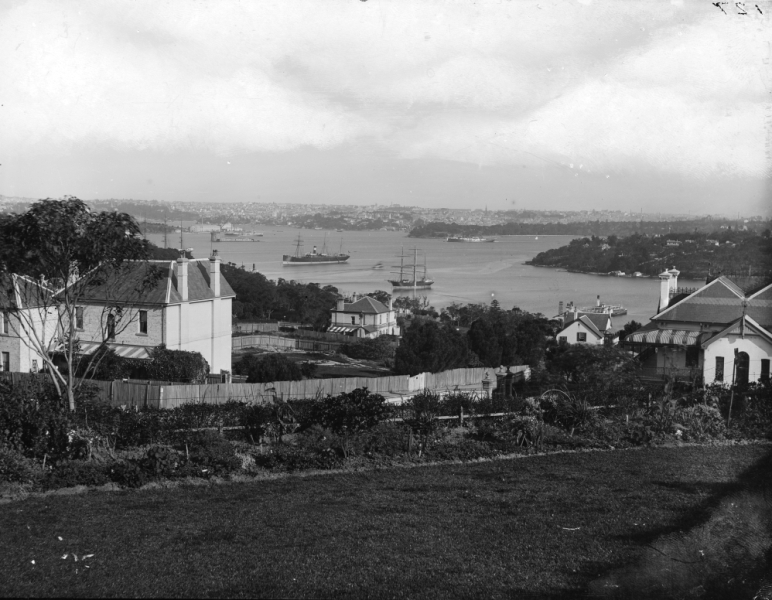
Neutral Bay view of Sydney Harbour, circa 1890-1900 from the Tyrell Collection, Image 386449, courtesy of Powerhouse Musueum.
James continued building in the surburbs around the harbour. His sons, two of whom served in WWI (Ernest and John, Ernest killed in France) continued to prosper in the building trade. James died while on a job site in Kurraba Road, Neutral Bay;
DEATH OF MR. J. G. VERRILS. The death occurred recently of Mr. J. G. Verrils, one of Sydney's oldest and best-known builders. He was 83, and was working up to the day of his death. He built many buildings in Sydney and more than 300 dwellings in the northern suburbs. He built the first house at Palm Beach in 1911. He is survived by six sons, three daughters, 31 grandchildren, and 43 great-grandchildren. DEATH OF MR. J. G. VERRILS. (1946, October 5). The Sydney Morning Herald (NSW : 1842 - 1954), p. 13. Retrieved from http://nla.gov.au/nla.news-article17997587
VERRILLS -September 11 1946 (suddenly) James George Verrills of 30 Spofforth Street Cremorne aged 83 years. Family Notices. (1946, September 12). The Sydney Morning Herald (NSW : 1842 - 1954), p. 16. Retrieved from http://nla.gov.au/nla.news-article27910244
Peter Verrills, grandson of Albert kindly provided a few insights on his grandfather;
He won the contract to build the Surveyors Cottage on the corner of Sunrise and Palm Beach roads. That’s gone now unfortunately; that should never have happened. So that was 1911 that he came to Palm Beach and they built the cottage which was only a one bedroom tiny little timber cottage and they lived in it until the Surveyors arrived. They thought this area was so great they were one of the first to purchase land. Albert wanted to stay here. That was 1911 and they eventually settled in 1915.
CARPENTERS.-Good Man wanted. A. Verrill's job, Barry-st, Neutral Bay, near Fire Station. Advertising. (1911, July 5). The Sydney Morning Herald (NSW : 1842 - 1954), p. 3. Retrieved from http://nla.gov.au/nla.news-article28135299
My grandmother was pregnant when they moved into the cottage; I think they bought the cottage for twenty eight pounds or thirty pounds. It became too small because there was seven of them, seven kids. They were building cottages. They built all the original homes. My old man (Fred, known locally as ‘Friendly Fred’.) was born in that surveyor’s cottage, in 1915.
Albert married Florence Hodge in 1906.
My old man was the second youngest and his brother, Bobby, who was about 12months younger then dad, got killed on the road above the Carrel Bay wharf carting milk. Him and another bloke, when they were 10 or 11 year old kids, who only went to school until about 6th class, school was finished for them by then, the big steel wheels ran over Bobby and he was killed poor bugger…very sad.
This incident was reported in all papers, nation wide;
Fall from a Milk Cart. Robert George Verrill, 10, residing at Barrenjoey-road, Palm Beach, was killed by falling from a milk cart in George-street, Careel Bay, early yesterday morning. Verrill was accompanying the driver, Roy Turner. A wheel of the cart struck a rut and the horse became startled and bounded forward, Verrill being thrown on to the road-way and a wheel passing over his body. He was at once taken to Manly District Hospital, but was dead. BOY KILLED. (1930, December 15). The Sydney Morning Herald (NSW : 1842 - 1954), p. 10. Retrieved from http://nla.gov.au/nla.news-article16738843
VERRILLS-December 14. Robert George, beloved son of Albert and Florence Verrills of Palm Beach aged 10 years.
VERRILLS-The Funeral of the late ROBERT GEORGE VERRILLS of Palm Beach will leave our Private Mortuary Chapel 92 Corso Manly THIS MORNINg (Tuesday) at 11 o clock for the Manly Cemetery T WAUGH and CO Funeral Directors Family Notices. (1930, December 16). The Sydney Morning Herald (NSW : 1842 - 1954), p. 9. Retrieved from http://nla.gov.au/nla.news-article16739218
My grandfather built and lived and owned where Barrenjoey House stands today. That was their place; that burnt in 1928. He then rebuilt the existing one that’s there now. He bought land opposite Nabilla road and built his family home there because the Government…they were having trouble with pilfering; the ships would bring all the timber around because there were no roads in. It was all stored on what we now call Pittwater Park, and they were having trouble with stuff getting pinched. So everything was stored there until the horse and cart could come and take it to where the job was, wherever they were building. And they’d lose too much so he had to keep and eye on it; which is consequently why they had Barrenjoey House and then when the wharf disappeared and was going to get relocated, they bought land up there at Nabilla Road; if you have a look at the original maps for here Nabilla Road was going to continue up the hill, which never happened.
A lot of the originals burnt. He built that big Palm Beach Boarding house up on the corner here that burnt down. Two of his houses are still in Florida Road; Kookaburra and Florida House, Gallagher did the stonework on that. They’re two beautiful places. The one just back from the corner there next to Florida House, up the top of that monstrous yard, he built that and that’s still here, and then they built Barrenjoey House. Up in Pacific Road, there’s a lot up there and there’s still a couple there; Elizabeth cottage and Willaroon and the Bishop’s on the corner.
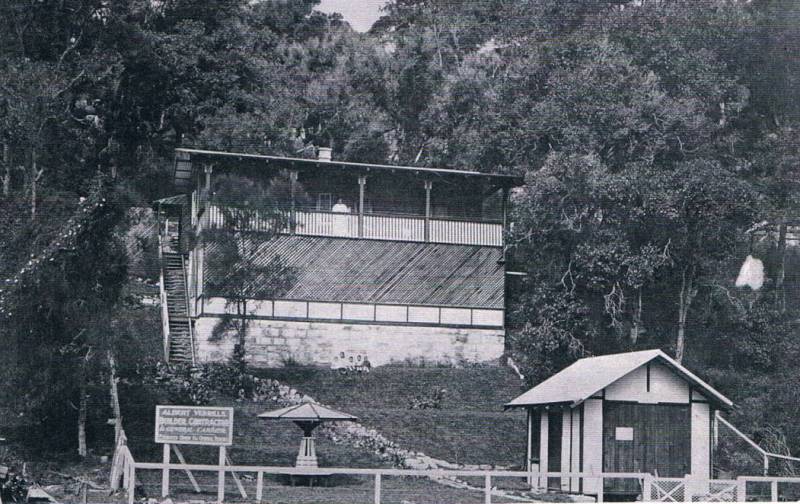
Albert's Home. Photos courtesy Peter Verrills
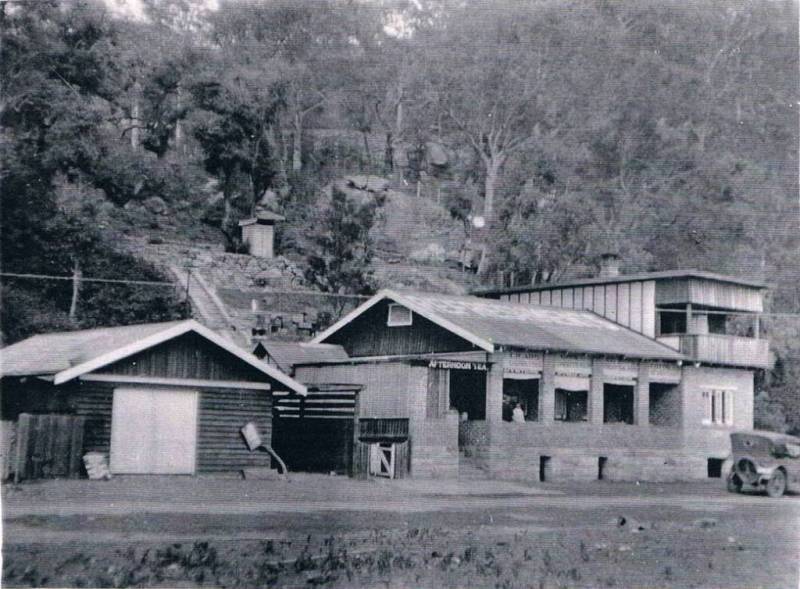
The original Barrenjoey House. Photo courtesy of Peter Verrills.
Where was Albert getting his materials from?
Mainly from Eatons. The Eatons were very big at Berrys Bay they had huge yards there, years before they had yards at Avalon and Forestville. Eatons took over Hayes Timber; Liz Hayes; they shipped it in from there.
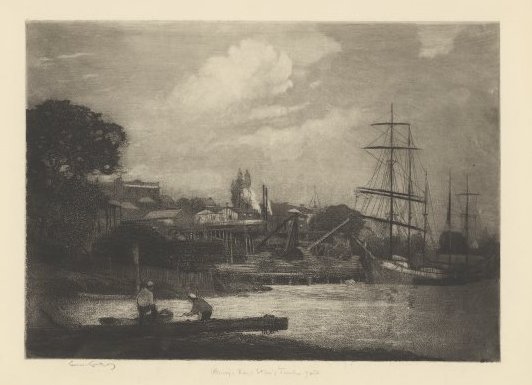
Eaton's timber yard, Berry's Bay, New South Wales, circa 1916 by Sir Lionel Lindsay. Image no: nla.pic-an10711203, courtesy National Library of Australia.
MR. J. W. EATON. Mr. John Wood Eaton, who died on Saturday, at the age of 85 years, was the founder and governing director of John W. Eaton Pty., Limited, timber merchants, of North Sydney. He was of Scottish parentage, but was born at Ashton-Under-Lyne, England, in 1852, arriving in Sydney at the age of five years in the Gipsy Bride. He lived in North Sydney for 80 years, and was educated at Fort Street school, daily rowing across the harbour. He was afterwards a builder, and in 1880 founded the firm of John W. Eaton Pty., Limited, at Junction and Arthur Streets, North Sydney, later removing to Blue's Point (Berrys Bay). Mr. Eaton was a member of the board of directors of the Royal North Shore Hospital for 27 years, 20 of which were served' as a vice-president. He took an active port in the raising of funds for patriotic purposes during and since the war. His wife pre-deceased him about three weeks ago, and he is survived by two sons, Messrs. J. K. and C. D. Eaton, and two daughters, Misses Ruby and Marjorie Eaton. The funeral will leave his late residence, Wahgunyah, Shirley Road, Wollstonecraft, at2.30 p.m. to-day, for the Northern Suburbs Cemetery. MR. J. W. EATON. (1938, June 20). The Sydney Morning Herald(NSW : 1842 - 1954), p. 7. Retrieved from http://nla.gov.au/nla.news-article17492569
Where were the ships that were bringing the timber coming from?
Peter: Sydney or the Hawkesbury. They were milling up the river and bringing it down from there. There was a wharf here too for offloading (Boat House wharf). I can remember one of these ships was called the Erringhi and another.. the Sackville; they were coming from up the river (Hawkesbury); And I remember the Surprise; they also used to bring stuff into the wharf below Newport pub; a hell of a lot of stuff came in there. Where the sailing club at Avalon is; there was a public wharf there too; they used to offload materials there as well….and Careel Bay; at Careel Bay that was old Freddy Sharer (pronounced –‘Shah- ER’).
Tom Gilbert, lifelong friend of Peter Verrills, whose father was a stonemason and fisherman relates how materials were moved once a road went in;
Tom: my dad used to be allotted rights at Manly Wharf, he had a truck, it (the materials) used to come across on the punt. They had the old hard tyre reos; they went to the opening of the Harbour Bridge on those; yeah Bottle’s Buses; Bertie; these were hard rubbered old Internationals; federals; we used to have to get out and push them up at Bilgola Beach, that was the road then, (now called the Serpentine) no Bilgola Bends.
Peter: The Phoenix would call into Gow’s, that would pick up my mum (Ellen Anne Gonslaves) and my old man and take them to school, and the Mulgraves, who were at the lighthouse, the lighthouse keepers children, all the Gonsalves, the Goddards and the Verrills.
Did Albert and Frederick build any roads out here?
Peter: No; Ericksons at Newport were the big family that built a lot of the roads into here and then the Websters came along. They both were given jobs to build roads; that was all crushed rock; they quarried rock. They (Verrills) were responsible for building a lot of the original buildings. They built everything of the original houses on Sunrise. One of the surveyors stayed on, Charlie Gillam. The original one they built up on Sunrise was for him, for his family. It looked straight this way (towards Station Beach).
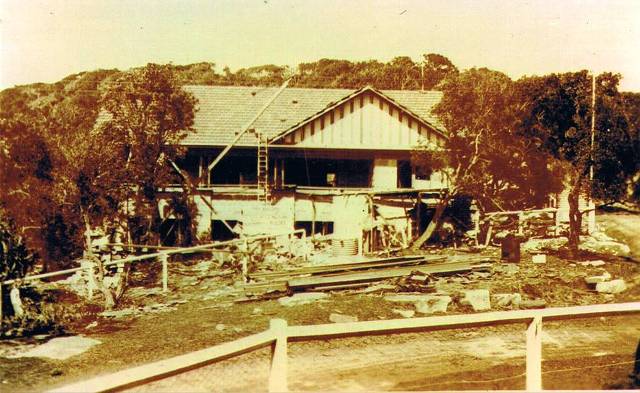
The Maitland home, built by Albert, Beach Road, Palm Beach. Image courtesy Lady Maitland and Peter Verrills.
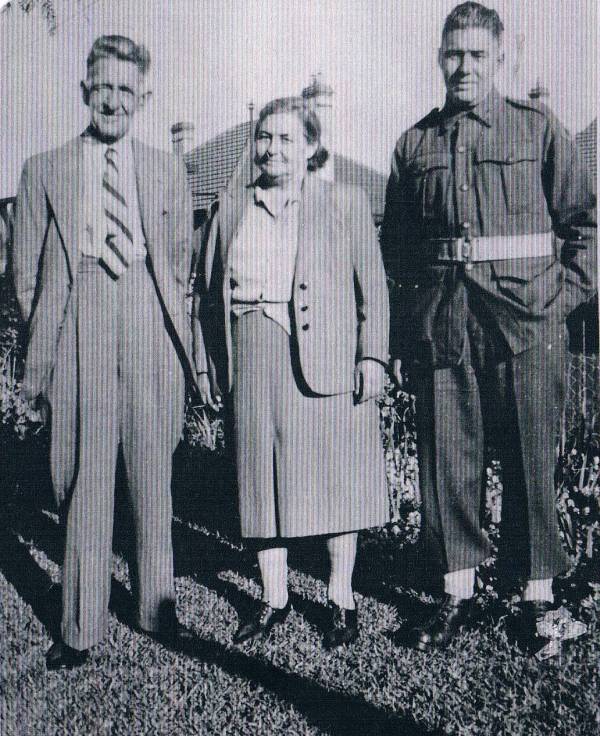 Right: Albert, Florence and Fred (Frederick Leonard, father of Peter) circa 1939. Picture courtesy Peter Verrills.
Right: Albert, Florence and Fred (Frederick Leonard, father of Peter) circa 1939. Picture courtesy Peter Verrills.
Albert was one of the pioneers out here; what was he like as a gentleman?
Peter: I was only about 16 when he died, when he wore out. I can only remember him as a rogue; he’d get a couple of drinks into him and he’d sing! He’d sing his bloody heart out…he’d go up to very woman he could see, sit down alongside them and say “I’m going to sing to you sweetie.” And away he’d start!
What songs was he singing?
Peter: All the old stuff. One of them that he used to sing to me, and I’ll never forget it, he’d say “come and sit over here son…” and then he’d sing “ Climb up on my knee sonny boy…though you’re only three sonny boy… there’s no way of knowing, there’s no way of showing what you mean to me sonny boy…” and away he’d would go…And then ‘School days’ was another one. Yeah…’school days, school days, dear old golden rules days..’
Another inkling into this Pittwater pioneer of infrastructure may be inkled in the following advertisement, one of the few you will ever see with a ‘duffer’s don’t apply’ notice;
Carpenter; good all round man required. No duffers. Albert Verrills. Palm Beach. Advertising. (1920, April 29). The Sydney Morning Herald (NSW : 1842 - 1954), p. 12. Retrieved from http://nla.gov.au/nla.news-article15887551
How many years did Albert build out here?
Albert’s last house, and that was after the war (WWII) which would have been about 1947 or 1948 was for the author Jon Cleary up in Boanbong road, corner of Cynthea and Boanbong. That was his last job. He built here from 1911 until 1947/48; he died not long after that. They moved to Dee Why but dad (Fred) stayed here, and Sid.
Jon Stephen Cleary (22 November 1917 – 19 July 2010) was an Australian writer and novelist. He wrote numerous books, including The Sundowners (1951), a portrait of a rural family in the 1920s as they move from one job to the next, and The High Commissioner (1966), the first of a long series of popular detective fiction works featuring Sydney Police Inspector Scobie Malone. A number of Cleary's works have been the subject of film and television adaptations.
Did you work on that job with him?
Peter: Yep, as a schoolkid I did; I worked weekends and after school. There was no water or electricity for the brickies and the building of the house; so down where the Palladian is, that was the bus terminus, there used to be a hydrant there for the buses because they all ran out of water by the time they got here and they’d top them up, we used to go down there with 44 gallon drums, and I was only about 14, I used to drive the truck and go down and fill the 44’s up with water and take them back up to the job. I used to love it; that was my job. On the weekends we were all on the job by 7 o’clock and knock off at 4.30. Then they’d get 10 or 12 of them in the utility truck and away they’d go to Newport pub; they had to get some drinking in because it was all over at six o’clock. They’d go there, get sixty thousand schooners into them and then they’d drive home.
They didn’t bring any beer home with them?
Peter: yeah, in their belly. It was rationed and pretty hard to get. We had a local brewery called ‘Brookie Brewery’ down at Brookvale and another one at Mudgee; and Grafton …but Mudgee was called ‘Mudgee Mud’
Tom Gilbert: and Grafton was called ‘Grafton Black’ or ‘Grafton Bitter’.
Peter: apparently none of it was any good.
Could you sharean amusing story or something that sticks out in your mind about Albert...
Peter: When it was the weekend he’d, because he made quite a bit of money, and I think he gambled a bit too, but he bought these beaut’ tourers, Hudson’s,.He’d load all of us, probably a dozen of us, because they were bloody big cars, and he’d load all of us kids and mum and dad and dad’s brothers and sister’s kids and away we’d go. And it was always up to the Blue Mountains. I can remember the running boards along the side, and he’d have about four spare wheels on either side because you’d get somewhere along the road and ‘bang’ you’ve got a puncture, and they’d change another wheel. It would be ten o’clock at night and in the dark by the time you’d be getting home because you’d have that many breakdowns and changing wheels. That’s what sticks in my mind; those trips and going away for picnics with him in the car. He never drove; one of the boys would drive. He bought the cars but someone else always drove. When they moved to Dee Why we’d still go there at least once a week. We’d catch the bus to Narrabeen and then in the tram and off to Dee Why.
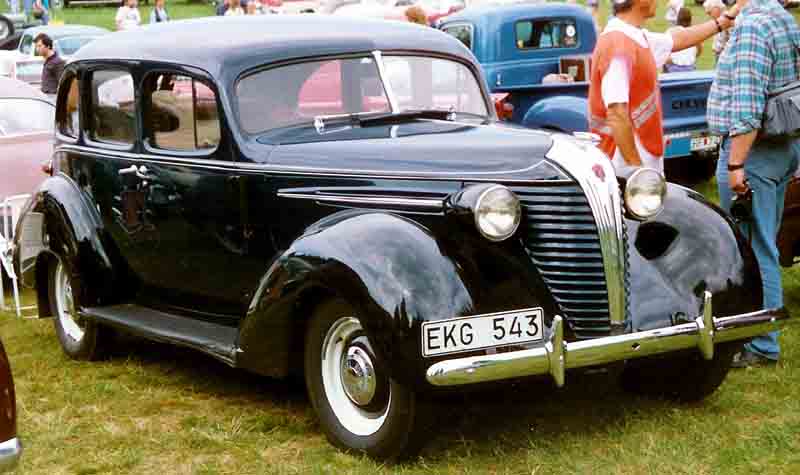
Hudson Terraplane 4-Door Sedan 1938 courtesy of Lars-Göran Lindgren, Sweden..
Albert Extras;
Palm Beach – furnished cottage for sale or will let on Lease. 4 rooms, Kit. Bathroom, Verandah 30 x 16, 6 mins to surf, surf boating and fishing good views A VERRILLS, Palm Beach Pittwater Advertising. (1919, January 4). The Sydney Morning Herald(NSW : 1842 - 1954), p. 11. Retrieved from http://nla.gov.au/nla.news-article15818631
Some of the Northern Beaches contracts Albert Won:
For a reinforced concrete amusement hall at Furlough House, Narrabeen (Mr. A Verrills, builder): GENERAL NOTES. (1920, August 25). The Sydney Morning Herald (NSW : 1842 - 1954), p. 8. Retrieved from http://nla.gov.au/nla.news-article15903827
For the erection of a shop and dwelling at Dee Why the same architect, Mr. Leonard Herbert, has let a contract to Mr. A. Verrills. BUILDINGS AND WORKS. GENERAL NOTES. (1923, September 26). The Sydney Morning Herald (NSW : 1842 - 1954), p. 11. Retrieved from http://nla.gov.au/nla.news-article16095929
William Hodge was my grandmother's brother - Florence married Albert Verrills - the Hodges lived in Palm Beach on the land where the car park is opposite the RSL which was the site of the first PO in Palm Beach.
HODGE.—October 24, 1945. at his residence, Barrenjoey Bead, Palm Beach, William Hodge, loved husband of Ellen (Mrs. Douglas). Florence (Mrs. Verrills), Anna (Mrs. Jolly), Evelyn (Mrs. Gibson), and Ted, aged 84 years.
HODGE.—October 24. 1945, at Palm Beach, William Hodge, beloved father, grandfather, and great grandfather of Mrs. A. R. Douglas and family, of Arthur Street. Deewhy. Family Notices (1945, October 25). The Sydney Morning Herald (NSW : 1842 - 1954), p. 14. Retrieved from http://nla.gov.au/nla.news-article27921295
Peter's father, Frederick Leonard Verrills, was a 2013 History page.

'Pill Hill' Palm Beach Blow up of Section from Panorama of Avalon Beach and Palm Beach region, New South Wales nla.pic-vn6149402, courtesy National Library of Australia, circa 1917 - 1946.
Al Jolson's second talking film, 'The Singing Fool', 1928 using vitaphone featured the great ballad he has now become famous for 'Sonny Boy'. Written in Atlantic City a few days before shooting, Bud De Sylva, Ray Henderson and Lew Brown sent this sentimental tearjerker to Jolson as a whim; it turned out to be the FIRST million selling recording! 'The Singing Fool' would eventually become 'Jolie's (and Americas) largest grossing talking film and it was to remain that way for 10 years until it was taken over by 'Gone With The Wind' in 1939.
Copyright Verrills family, 2013. Peter Leonard Verrills Profile Page.Threads collected and collated by A J Guesdon, 2013